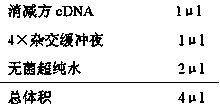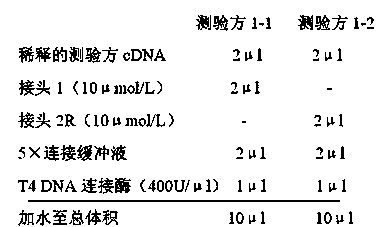Calmodulin gene and application thereof
A calmodulin and gene technology, which is applied in the field of genetic engineering to achieve the effects of increasing aluminum resistance, simple operation and low technical cost
- Summary
- Abstract
- Description
- Claims
- Application Information
AI Technical Summary
Problems solved by technology
Method used
Image
Examples
Embodiment 1
[0021] Example 1: Cryptococcus terrestris ( C . humicolus ) Cloning and identification of CaM gene of BSLL1-1 strain
[0022] A strain of Cryptococcus terrestris with high resistance to aluminum ions isolated from the acidic soil in the rhizosphere of tea gardens around Longling County, Baoshan City, Yunnan Province ( C . humicolus ) BSLL1-1 strain, collect about 0.1g of bacterial material, extract 500μg of total RNA using TRIzoL kit (Invitrogen), and then use PoylATract mRNA Isolation systems kit (Pormega) for mRNA isolation. The aluminum-treated Cryptococcus terrestris was used as the test method, and the aluminum-treated Cryptococcus terrestris was used as the subtractive method to construct a forward SSH cDNA library of Cryptococcus terrestris.
[0023] 1. Synthesis of the first strand of cDNA
[0024] Take 2μg of mRNA from the test recipe and the subtracted recipe respectively, and use AMV reverse transcriptase to reverse transcribe the mRNA into the first strand of cDNA. Th...
Embodiment 2
[0071] Example 2: Heterologous expression of CaM protein
[0072] In order to facilitate the construction of expression vectors, specific primers are designed according to the nucleotide sequence and introduced at the 5'ends of the upstream and downstream primers respectively Eco RI and Xho I restriction site, the primer sequence is as follows: forward primer CaM-F: 5’-CG GAATTC ATGGCGGAGCAGCTGACCAAG-3’ (underlined Eco RI restriction site), reverse primer CaM-R: 5’-GGC CTCGAG TTACTTGGCC ATCATCATGGTAAC -3’ (underlined Xho I restriction site). The cDNA of Cryptococcus terrestris was used as a template to amplify the CaM gene fragment. The PCR reaction conditions were as follows: pre-denaturation at 94°C for 3 minutes, followed by 30 cycles of denaturation at 94°C for 30s, annealing at 68°C for 30s, and extension at 72°C for 45s, and a reaction at 72°C for 10 minutes at the end of the cycle. The PCR product of the CaM gene was subcloned into the pMD18-T vector. The obtained T...
Embodiment 3
[0075] Example 3: Construction and detection of CaM transgenic yeast
[0076] use Eco RI and Xho I digested and sequenced the correct pMD-18T-CaM plasmid, and recovered the target gene CaM fragment. use Eco RI and Xho I digest the yeast expression vector plasmid pYES3 / CT, recover the linear vector pYES3 / CT fragment, and then ligate the two to obtain the pYES3 / CT-CaM plasmid. The pYES3 / CT-CaM plasmid was digested with double enzymes to obtain a band of the target fragment size ( figure 2 A), indicating that the target gene is successfully connected to the yeast expression vector. The pYES3 / CT-CaM plasmid carrying the CaM gene was electroporated into Saccharomyces cerevisiae INVSc1 competent cells. Long on SD-Trp plate for 2-3 days, pick a single colony, culture overnight at 30°C, collect the bacteria and extract the total protein, use CaM antibody for Western blotting detection, the target protein band can be detected in the transgenic yeast strain ( figure 2 B), indicati...
PUM
| Property | Measurement | Unit |
|---|---|---|
| molecular weight | aaaaa | aaaaa |
Abstract
Description
Claims
Application Information
 Login to View More
Login to View More - R&D
- Intellectual Property
- Life Sciences
- Materials
- Tech Scout
- Unparalleled Data Quality
- Higher Quality Content
- 60% Fewer Hallucinations
Browse by: Latest US Patents, China's latest patents, Technical Efficacy Thesaurus, Application Domain, Technology Topic, Popular Technical Reports.
© 2025 PatSnap. All rights reserved.Legal|Privacy policy|Modern Slavery Act Transparency Statement|Sitemap|About US| Contact US: help@patsnap.com



